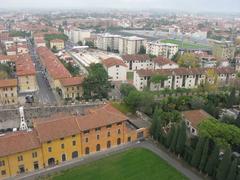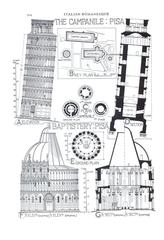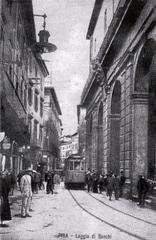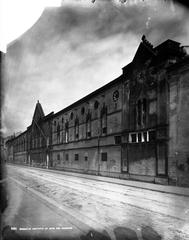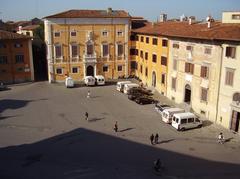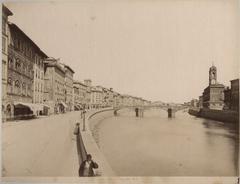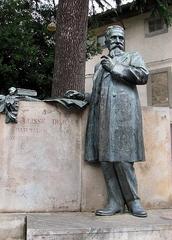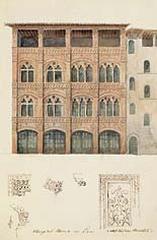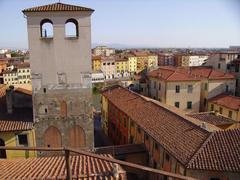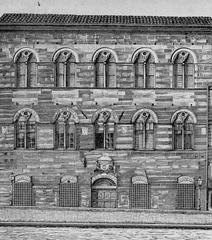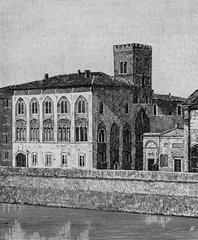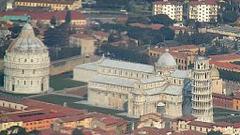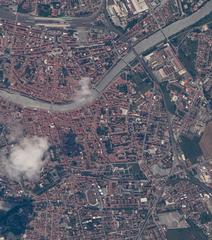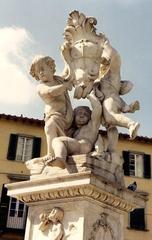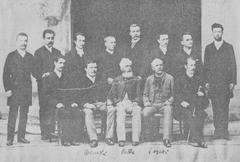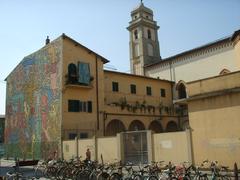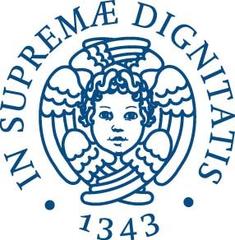Domus Mazziniana Visiting Hours, Tickets, and Guide to Pisa Historical Sites
Date: 04/07/2025
Introduction: Discovering the Domus Mazziniana in Pisa
The Domus Mazziniana, located in the heart of Pisa, is a unique historical museum and research institute dedicated to Giuseppe Mazzini, a central figure in Italy’s 19th-century Risorgimento. Housed in the very building where Mazzini spent his final days, the Domus serves as a dynamic hub for cultural, academic, and civic engagement. It not only preserves invaluable artifacts, manuscripts, and memorabilia but also actively promotes democratic ideals and historical awareness through a vibrant calendar of events, exhibitions, and educational initiatives.
Whether you are a history enthusiast, a student, or a traveler exploring Pisa’s rich heritage, the Domus Mazziniana is an essential site to visit. Its central location, accessibility, and integration within Pisa’s historical and cultural landscape make it a truly enriching stop on any itinerary. For up-to-date information on visiting hours, ticketing, accessibility, and events, consult official resources such as MuseumRun, the Domus Mazziniana Official Site, and Comune di Pisa.
Contents
- Giuseppe Mazzini: Life and Historical Context
- Mazzini’s Role in the Risorgimento
- The Palazzo Nathan-Rosselli: Mazzini’s Final Days
- Mission, Collections, and the Living Memorial
- Annual Commemorative Events and Civic Celebrations
- Educational and Scholarly Initiatives
- Artistic and Theatrical Programs
- Museum Architecture and Symbolism
- The Archives: Scope and Access
- Visitor Information: Tickets, Hours, and Accessibility
- Guided Tours and Visitor Experience
- Nearby Attractions and Travel Tips
- Frequently Asked Questions (FAQ)
- Summary and Visitor Tips
- Sources and Official Links
Giuseppe Mazzini: Life and Historical Context
Giuseppe Mazzini (1805–1872) was a passionate advocate for republicanism, democracy, and national unification. Born in Genoa, he began his political activism in the Carbonari before founding Giovine Italia (Young Italy) in 1831, a movement striving for a unified, democratic Italy. Mazzini’s influence extended well beyond Italy, inspiring nationalist movements across Europe and advocating for a federation of free peoples. Despite years of exile and political setbacks, his steadfast dedication made him a symbol of liberty and justice (MuseumRun).
Mazzini’s Role in the Risorgimento
During the Risorgimento, Mazzini provided the ideological foundation for Italian unification. Through Giovine Italia and later Giovine Europa, he coordinated revolutionary activities and shaped the discourse around national identity and popular sovereignty. His vision, distinct in its emphasis on democracy and social justice, often contrasted with the strategies of figures like Cavour and Garibaldi, yet remained a guiding light for Italy’s republican aspirations (Renato Prosciutto).
The Palazzo Nathan-Rosselli: Mazzini’s Final Days
The museum is housed in the historic Palazzo Nathan-Rosselli, where Mazzini died on March 10, 1872. Declared a national monument in 1910, the building was heavily damaged in WWII but rebuilt and re-inaugurated in 1952. The reconstructed Domus preserves the spirit of the original, offering a space for both remembrance and active research (Renato Prosciutto).
Mission, Collections, and the Living Memorial
The Domus Mazziniana is more than a museum; it is a living memorial and public research institute. Its mission is to safeguard and promote Mazzini’s legacy and the broader Risorgimento movement. The collections feature original manuscripts, autographs, photographs, and memorabilia from Mazzini and other figures of the period. Regular exhibitions—permanent, thematic, and temporary—immerse visitors in the complexities of 19th-century Italy and the ideals that shaped modern Europe (MuseumRun).
The museum’s commitment to accessibility and free or low-cost admission ensures that Mazzini’s message remains available to all.
Annual Commemorative Events and Civic Celebrations
Every March, the Domus Mazziniana organizes commemorations marking Mazzini’s death. The 153rd anniversary in 2025 included:
- Ceremonial Tributes: Wreath-laying at the Mazzini monument in Piazza Mazzini, attended by civic and military authorities.
- Open House: Free museum access, inviting the public to explore collections and historical spaces.
- Official Commemoration: Lectures and performances in the Aula Magna of Polo Carmignani, open to the public with reservation (gonews.it).
Educational and Scholarly Initiatives
As a hub for civic education and scholarly exchange, the Domus Mazziniana regularly hosts:
- Lectures and Seminars: Programs such as “LungOttocento” explore topics like civic associations and solidarity. In 2025, historian Sondra Cerrai presented her book on Pubblica Assistenza SR Pisa (pisainvideo.it).
- Book Presentations and Debates: Including the “Clioscopio” series, which in 2025 featured discussions on the legacy of social democracy.
- Conferences: Major national and international conferences, including the publication “Il Mazzinianesimo nel mondo,” highlight Mazzini’s influence (gonews.it).
Artistic and Theatrical Programs
Cultural engagement is furthered through:
- Theatre Productions: “Risorgimento Pop,” a contemporary interpretation of the Risorgimento, was staged at Teatro Nuovo in 2025.
- Workshops and Panels: Artists and historians discuss historical storytelling and the representation of history on stage.
- Music: Concerts such as the premiere of “La Terza Italia – Inno a Giuseppe Mazzini,” composed by Manfred Giampietro, enrich the commemorative program (gonews.it).
Museum Architecture and Symbolism
The Domus’s architecture merges tradition with modernity. The rebuilt façade on Via Massimo d’Azeglio features steel letters spelling out the Oath of Giovine Italia, visually reinforcing Mazzini’s ideals of unity and freedom. Inside, the museum’s spaces are designed for reflection, learning, and engagement with Italy’s historical journey.
The Archives: Scope and Access
The Domus Mazziniana’s archives, housed at the Centro Archivistico of the Scuola Normale Superiore in Pisa, contain hundreds of original documents, rare books, and photographs documenting Mazzini’s life and the development of modern Italy. Scholars can access the archives by appointment, and digitization projects are expanding remote access (Domus Mazziniana Archive). Since 2002, the Domus is recognized as an Istituto Storico di Interesse Nazionale and a “place of memory.”
Visitor Information: Tickets, Hours, and Accessibility
- Location: Via Giuseppe Mazzini, Pisa, Italy
- Visiting Hours: Generally open Monday to Friday (with extended hours during commemorative events like those in March); standard hours are typically 10:00 AM–6:00 PM. Always confirm on the official website.
- Tickets: Admission is free or very low-cost; some events may require advance reservation (gonews.it).
- Accessibility: The museum is fully accessible to visitors with disabilities, with ramps, elevators, and accessible restrooms.
- Languages: Most programming is in Italian, but arrangements for English-speaking visitors can be made.
- Guided Tours: Offered regularly and often free during special events. Educational visits for schools and universities can be arranged.
Guided Tours and Visitor Experience
Guided tours, led by expert staff or curators, provide a deeper understanding of both Mazzini’s life and the Risorgimento. Tours are available by reservation and are frequently free during commemorative periods. Educational programs and workshops cater to students and international visitors, promoting civic and historical literacy.
Nearby Attractions and Travel Tips
- Combine Your Visit: The Domus Mazziniana is centrally located—combine your tour with visits to the Leaning Tower, Piazza dei Cavalieri, Museo Nazionale di San Matteo, and Palazzo Blu.
- Transport: Easily accessible by public transit or on foot from major Pisa landmarks. Limited parking is available; public transport is recommended.
- Plan Ahead: During events and commemorative periods, reserve your spot in advance.
Frequently Asked Questions (FAQ)
Q: What are the Domus Mazziniana’s visiting hours?
A: Generally Monday to Friday, 10:00 AM–6:00 PM, with extended hours during special events. Always check the official website for updates.
Q: Is admission free?
A: Yes, most exhibitions and events are free; some may require a modest fee or reservation.
Q: Are guided tours available?
A: Yes, guided tours are regularly offered and can be booked in advance.
Q: Is the museum accessible to visitors with disabilities?
A: Yes, the building is fully accessible.
Q: How do I access the archives?
A: Archives are accessible by appointment for scholars and students; some digital resources are available online (Domus Mazziniana Archive).
Summary of Key Points and Visitor Tips
The Domus Mazziniana offers a comprehensive experience that bridges historical scholarship, civic engagement, and public programming. Its rich collections, annual commemorations, academic seminars, theatrical performances, and guided tours make it a cornerstone for understanding both Giuseppe Mazzini’s pivotal role in the Risorgimento and the evolution of democratic ideals in Italy. Its accessibility, central location, and free or affordable admission ensure that visitors of all backgrounds can connect deeply with Italy’s past. Before your visit, check the official channels for the latest updates on schedules and events (gonews.it, Domus Mazziniana Official Site).
Sources and Official Links for More Information
- MuseumRun: Visiting the Domus Mazziniana in Pisa: Hours, Tickets & History of Giuseppe Mazzini
- Comune di Pisa - Domus Mazziniana
- Domus Mazziniana Official Site
- Gonews.it - Domus Mazziniana Visiting Hours, Tickets, and Cultural Activities in Pisa
- Finestre sull’Arte
- Visit Tuscany
- Terre di Pisa
- Turismo Pisa
